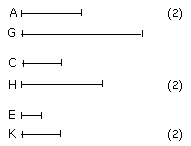Ratios which are the same with the same ratio are also the same with one another.
 For, as A is to B, so let C be to D,
For, as A is to B, so let C be to D,
 and, as C is to D, so let E be to F;
and, as C is to D, so let E be to F;
 I say that, as A is to B, so is E to F.
I say that, as A is to B, so is E to F.
 For of A, C, E let equimultiples G, H, K be taken,
For of A, C, E let equimultiples G, H, K be taken,
 and of B, D, F other, chance, equimultiples L, M, N.
and of B, D, F other, chance, equimultiples L, M, N.
 Then since, as A is to B, so is C to D,
Then since, as A is to B, so is C to D,
 and of A, C equimultiples G, H have
been taken, and of B, D other, chance, equimultiples L, M, therefore, if G is
in excess of L, H is also in excess of M, if equal, equal, and if less, less.
and of A, C equimultiples G, H have
been taken, and of B, D other, chance, equimultiples L, M, therefore, if G is
in excess of L, H is also in excess of M, if equal, equal, and if less, less.
 Again, since, as C is to D, so is E to F
Again, since, as C is to D, so is E to F
 and of C, E equimultiples H, K have
been taken, and of D, F other, chance, equimultiples M, N, therefore, if H is
in excess of M, K is also in excess of N,
if equal, equal, and if less, less.
and of C, E equimultiples H, K have
been taken, and of D, F other, chance, equimultiples M, N, therefore, if H is
in excess of M, K is also in excess of N,
if equal, equal, and if less, less.
 But we saw that, if H was in excess of M, G was also in excess of L; if equal,
equal; and if less, less;
But we saw that, if H was in excess of M, G was also in excess of L; if equal,
equal; and if less, less;
 so that, in addition, if G is in excess of L, K is also in excess of N, if
equal, equal, and if less, less.
so that, in addition, if G is in excess of L, K is also in excess of N, if
equal, equal, and if less, less.
 And G, K are equimultiples of A, E, while L, N are other, chance,
equimultiples of B, F; therefore, as A is to B, so is E to F.
And G, K are equimultiples of A, E, while L, N are other, chance,
equimultiples of B, F; therefore, as A is to B, so is E to F.
Therefore etc.
Q.E.D